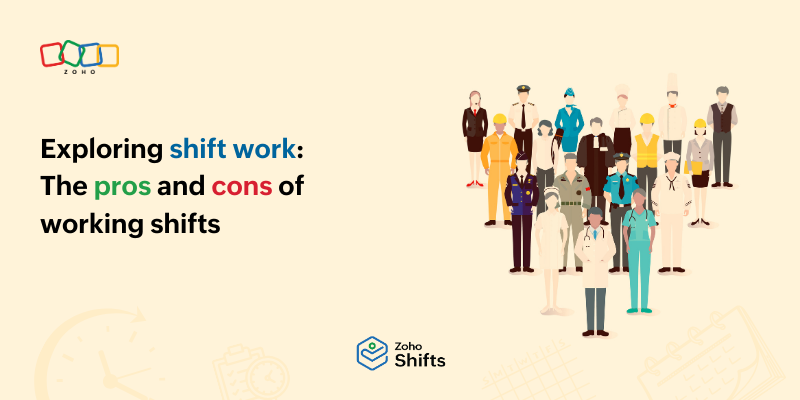- HOME
- Shift Scheduling
- Streamline your workforce with comprehensive employee scheduling software
Streamline your workforce with comprehensive employee scheduling software
- Last Updated : May 16, 2024
- 557 Views
- 7 Min Read
Proper employee scheduling is essential for operational efficiency, productivity, and work-life balance across various sectors and industries.
But why is it so crucial?
Customer demand can fluctuate based on seasonal trends, holidays, promotions, and special events. Managing worker shifts effectively poses a challenge, especially when it comes to assigning the right shifts to employees with the necessary skills set, ensuring everyone is available when needed, and complying with labor laws. The right employee scheduling software can help simplify and make it much easier to manage your staffing needs efficiently and effectively.
What is employee scheduling software?
Why does shift scheduling matter?
Importance of employee scheduling software
Types of employee work schedules
Features to look for in employee scheduling software
How can employee scheduling software help you save money?
Improve the office's work environment with the right employee scheduling software
Steps on how to use employee scheduling software
Why Zoho Shifts?
What is employee scheduling software?
Employee scheduling software is tailored for scheduling, time tracking, and communication needs within organizations. It's designed for businesses that want to scale their operations and simplify staffing tasks. Implementing scheduling software is essential, as it saves both time and increases productivity.
Why does shift scheduling matter?
When we talk about scheduling, we also talk about how we optimize workplace roster management to maximize productivity, efficiency, and employee satisfaction. Shift scheduling helps boost the company's bottom line, reduce staff workload, and provide a better customer experience.
Learn more about why effective scheduling is key to workforce optimization.
Importance of employee scheduling software
Optimized productivity:
Proper scheduling ensures the necessary number of employees with the right skill set are available at a specific time. Staffing helps ensure operational efficiency by minimizing understaffing or overstaffing.
Work-life balance:
Flexible staffing gives employees the freedom to choose their own shifts and strike a better work-life balance. The flexibility also allows employers to accommodate sudden absenteeism and make quick adjustments to employee shifts if needed.
Cost control:
Scheduling software helps control labor costs by avoiding overtime and shift differential expenses for employees. Optimizing your staffing levels prevents unnecessary labor expenses while ensuring adequate coverage during peak hours.
Compliance with labor laws:
Shift scheduling helps adhere to labor laws and regulations based on country, region, or area. Non-compliance can lead to legal issues and financial penalties.
Collaboration with team members:
Communicate with your team members via direct chats or channels. Fostering a culture of open communication will help build a positive work culture, a satisfied workforce, and overall improved performance.
Deeper insights:
Leverage the data to gain insights into future staffing requirements and avoid overstaffing or understaffing. These insights help identify patterns, optimize shifts, and predict future staffing costs.
Success and growth:
Success and growth are the fundamental aspects of any business. Overall, employee scheduling software helps reduce labor costs, improve staff satisfaction, and make the team become more cohesive.
Types of employee work schedules
Full-time schedule:
Full-time schedule refers to the shifts that have 37–40 hours a week. This can be either eight hours per day for five days, ten hours for four days, or six and a half hours for six days. Here, the days don't matter; rather, the working hours are calculated. In this case, we might expect overtime pay from employers as the working hours are fixed, and this may cost us more due to overtime.
Part-time schedule:
Part- time employees work fewer hours than the full-time employee. Here, the employees may work for two or three days in a week and need not be working for 37–40 hours a week. They may also be exempt from some benefits—like health insurance—that are generally given to full-time employees. This part-time work may only be available during special occasions and for certain types of business (e.g., restaurant, cafes, retail stores).
Freelance schedule:
A freelancer works their own schedule while following particular deadlines. If hiring on a freelance basis, you have to find a person you can trust to get the job done before the set time.
Fixed schedule:
A fixed schedule is similar to a full-time schedule, but in this case, employees work the same hours on the same day each week. But not all employees have a Monday to Friday timetable. Some employees may also work for three 12 hour shifts from Monday to Wednesday.
Split schedule:
A split schedule means that an employee may work a few hours and also have substantial breaks between their shifts. For example, say your employee works from 8 a.m. to 12 p.m. and again from 5 p.m. to 9 p.m. It's important that you are aware of the state labor laws for your area, as some local, state, and federal laws have rules pertaining to the to the minimum amount of time between two splits.
Flex work schedule:
Flex schedules are also referred to as flexible schedules or flex time. Flex schedules allow employees to create schedules that work for them, (i.e., the schedule is less rigid, so employees can define most of their working hours). Here, the employee does not need to go to the office regularly, and it's not important for them to follow a 9-to-5 schedule. But this also comes with the exception that employees may need to go to the office when necessary.
Rotating schedule:
For a 24/7 organization, a rotating work schedule is great because it lets employees switch their shifts. This ensures everyone gets fair hours, and nobody gets stuck with the less popular shifts all the time.
Seasonal schedule:
Seasonal schedules work well for businesses that are open only for a few months each year. Here, companies mass-hire staff when these seasonal requirements arise. These schedules can be demanding, as the employees may have to work long hours during the seasonal trends.
Features to look for in employee scheduling software
Core features:
Assess the core features, such as the drag-and-drop scheduling option, staff schedule templates, time-off management, flexible shift swapping, and compliance with labor laws.
User-friendly interface:
Make sure your employee scheduling software is intuitive and user-friendly for all. This will allow employees to easily navigate the platform, which can reduce the training curve and ease employee adoption.
Customization option:
Look for an application that offers customization options that meet your scheduling needs. This can be as simple as the ability to create schedules using templates, provide flexibility to create shift preferences, offer kiosk application accessibility, trigger notifications, and send reminders.
Calendar sync:
Sync employee work schedules with personal calendars such as Zoho Calendar, Google Calendar, Outlook, or Apple Calendar. By enabling calendar sync, employees can easily view their work schedules alongside their other commitments. This helps employees manage their time effectively and reduce scheduling conflicts.
Track time from anywhere:
Employee scheduling software comes with a time tracking feature to calculate the scheduled hours and the logged hours. If your business needs employees to go to the location, you should have geo-fencing capabilities to verify that employees are clocking in from the desired location. This gives a clear picture of time theft, clocked hours, and fair pay. Learn more about time tracking and related features.
How can employee scheduling software help you save money?
Labor costs reduction:
The right employee scheduling software helps you track employee hours accurately. It helps eliminate the risk of overpaying for no shows, and cost control significantly reduces labor expenses and increases profitability.
Overtime management:
Monitor employee-logged hours in real time and get alerts when employees are approaching the overtime thresholds. This allows for better workforce planning, reducing the need for costly overtime pay.
Productivity improvement:
Tracking employee logged hours on a regular basis helps businesses identify areas where productivity can be improved. This reduces time wasted on unproductive activities, leading to significant cost savings over the long term.
Compliance and labor law adherence:
Employee scheduling software helps businesses adhere to wage and hour laws, break time regulations, and other labor laws. It's crucial to avoid costly penalties and legal issues to reduce the risk of financial setbacks.
Improve the office's work environment with the right employee scheduling software
Understand your business needs:
Gain a better understanding of peak hours and what the business needs to achieve. For example, say the need is to provide excellent customer service and make sure employees are available during busy times. To do this, you would determine the optimal staffing levels needed to manage operations during peak hours.
Utilize employee scheduling software:
Steamline your roster process with the right employee scheduling software. The software should have features like shift swapping, time-off requests, and employee availability, which help create efficient shifts for the workforce.
Compliant with labor laws:
Calculating working hours involves considering factors like breaks, meal times, and any legal requirements regarding maximum working hours.
Implement flexible scheduling options:
Distributing the shifts among all employees with the right skill set, availability, and preferences. This gives the employees freedom to indicate their preferences for a better work-life balance.
Learn more about how to improve your workplace with the right employee scheduling software.
Steps on how to use employee scheduling software
Make a comprehensive employee list:
Create a detailed list of your current employees and start assigning working hours. This list helps you to make informed decisions regarding scheduling, training, and resource allocation.
Understand employee schedule needs:
Create employee schedules based on business needs, determining customer trends to identify peak hours, complexity of tasks, service speed, and customer demand.
Collect shift preferences from employees:
Give employees the freedom to mark their availability, preferences, and unavailability for a better work-life balance.
Assign shifts to employees:
Assign shifts based on the employee's availability and preferences. Always create a schedule based on how many positions you need to fill each day before beginning the scheduling process.
Ask for employee feedback:
Getting feedback from employees after finishing the first draft of your schedule is important for employee management. After you receive feedback from employees, make changes to the schedules if necessary and implement other efforts to increase employee job satisfaction.
Why Zoho Shifts?
Zoho Shifts is employee scheduling software for SMBs who manage shift-based employees. It offers an affordable and easy-to-set-up application, so you can focus on scaling your business operations. Transform the way you work with Zoho Shifts. Check out our website to learn more about our offerings and features.



